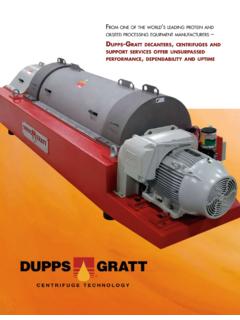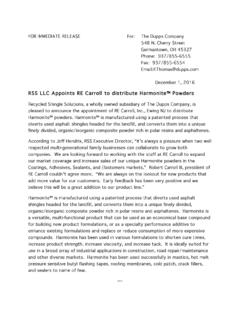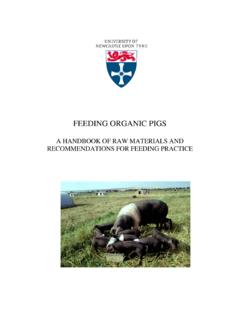Transcription of Poultry feed availability and nutrition in developing ...
1 1 FOOD AND AGRICULTURE ORGANIZATION OF THE UNITED NATIONS Poultry DeveloPment reviewPoultry feed availability and nutrition in developing countriesMain ingredients used in Poultry feed formulationsVelmurugu Ravindran, Monogastric Research Centre, Institute of Food, nutrition and Human Health, Massey University, Palmerston North, New ZealandFeed represents the major cost of Poultry production, constitut-ing up to 70 percent of the total. Of total feed cost, about 95 percent is used to meet energy and protein requirements, about 3 to 4 percent for major mineral, trace mineral and vitamin require-ments, and 1 to 2 percent for various feed additives. Poultry diets are formulated from a mixture of ingredients, including cereal grains, cereal by-products, fats, plant protein sources, animal by-products, vitamin and mineral supplements, crystalline amino ac-ids and feed additives.
2 These are assembled on a least-cost basis, taking into consideration their nutrient contents as well as their unit prices. Table 1 shows common ingredients used in Poultry feed formulations in most parts of the world. Main ingredients: availability issuesEnergy sources constitute the largest component of Poultry di-ets, followed by plant protein sources and animal protein sources. Globally, maize (corn) is the most commonly used energy source, and soybean meal is a common plant protein source. However, other grains such as wheat and sorghum, and plant protein meals such as canola meal, peas and sunflower meal are also widely used in some countries. The main animal protein ingredients are fishmeal and meat meal. Almost all developing countries are net importers of these ingredients; the Poultry feed industries in Afri-ca and Asia depend on imports, which are a drain on their foreign exchange reserves.
3 Quite often, the semi-commercial and com-mercial sectors in these countries are forced to limit their output of compounded feeds. The diversion of grains, particularly maize, from the animal feed market to ethanol production is a major recent development that has caused severe grain supply problems in the world mar-ket, with dramatic price increases. With government policies to promote the use of biofuels, the global production of ethanol has rapidly increased in recent years, and further large increases are expected in the future. Despite record prices, the import de-mand for main ingredients in developing countries continues to increase to meet the feed demands of an expanding Poultry sec-tor, putting further pressure on prices. Paradoxically, the solution for the rocketing price of maize could come from the biofuel in-dustry, through its major co-product distillers dried grains with solubles (DDGS) which has been shown to be a good source of available amino acids and energy.
4 Worldwide, feed millers are showing keen interest in DDGS because of its cost-effectiveness and ready availability . Good-quality DDGS is a potentially useful feed ingredient, containing about 25 percent protein and 10 per-cent fat, and rich mineral and vitamin resources. The amino acid availability in DDGS is similar to that in soybean meal. This may be the only raw material whose supply is assured and will increase in the energy sourceThe predominant feedgrain used in Poultry feeds worldwide is maize. This is mainly because its energy source is starch, which is highly digestible for Poultry . In addition, it is highly palatable, is a high-density source of readily available energy, and is free of anti-nutritional factors. The metabolizable energy value of maize is generally considered the standard with which other energy sources are compared.
5 In North America and Brazil, the feed industry has benefited from surplus maize, resulting from increased mechanization and the application of genetic and agronomic techniques to raise pro-ductivity. In the Asian and African regions, however, maize yield per hectare is low, and in most countries, production has never been sufficient to meet the needs of the growing human popula-tion. The net result is a continuing shortage of maize for feed use in these other energy source that meets most of the same criteria as maize is low-tannin sorghum. Sorghum can be grown in low-rain-fall areas and is a popular crop in hot, drought-prone regions. The high tannin content of many older sorghum varieties limits their use in Poultry diets, but low-tannin varieties are now available and can be used in Poultry diets without any limitation.
6 The energy value of low-tannin sorghum is 90 to 95 percent that of Energy sources: - cereals (mainly maize),1 cereal by-products- animal fats and vegetable oils2. Plant protein sources:2 soybean meal3. Animal protein sources: fishmeal, meat and bone meal4. Mineral supplements:- calcium supplements: limestone, shell grit- calcium and phosphorus supplements: dicalcium phosphate, defluorinated rock phosphate, bone meal- trace minerals: trace mineral premixes- sodium sources: salt, sodium bicarbonate5. Miscellaneous:- vitamin supplements: vitamin premixes- crystalline amino acids: methionine, lysine, threonine- non-nutritive feed additives: enzymes, antibiotics, 1 Common ingredients used in typical Poultry feed formulations1 Wheat and sorghum are widely used in some parts of the Canola meal, peas and sunflower meal are also used in some parts of the DeveloPment review Poultry feed availability and nutrition in developing countriesMain Plant Protein sourceAfter energy-yielding raw materials, protein supplements consti-tute the largest component of Poultry diets.
7 Plant protein sources supply the major portion of dietary protein (or nitrogen) require-ments. The plant protein source traditionally used for feed manu-facture is soybean meal, which is the preferred source for Poultry feed . Soybean meal contains 40 to 48 percent crude protein, de-pending on the amount of hulls removed and the oil extraction procedure. Relative to other oilseed meals, soybean protein has a good balance of essential amino acids, which can complement most cereal-based diets. The amino acid availability in soybean meal is higher than those for other oilseed meals. The metabo-lizable energy content is also substantially higher than in other oilseed soybeans contain several anti-nutritional factors, including protease inhibitors, which can negatively affect protein digestion and bird performance.
8 However, these inhibitors are destroyed by heat during the processing of soybean meal. Properly processed soybean meal is an excellent protein source for all classes of poul-try, with no restrictions on its production has increased substantially over the past two decades to meet the rising demands for oil for the human food market and meal for the animal feed market. The major pro-ducers of soybeans are the United States, Brazil and Argentina, which are also the major exporters. More than 50 percent of the current crop is now genetically modified (GM), mainly for herbi-cide tolerance, and there is an ongoing debate and campaign to reject GM ingredients from animal diets. If GM sources are not accepted in the market place, the potential for further nutritional quality enhancement and increased productivity will be limited.
9 Main aniMal Protein sourcesWith the notable exception of soybean meal, plant protein sourc-es are generally nutritionally imbalanced in terms of essential ami-no acids, particularly lysine, the first limiting amino acid in cereals. Unless supplemented with animal protein sources and crystalline amino acids, plant-based diets may not meet the requirements for critical amino acids for egg and meat production. Owing to their high prices, animal protein ingredients are normally used to balance the amino acid contents of diets rather than as major sources of protein. In many countries, feed manufacturers ensure that animal protein ingredients do not fall below minimum levels in Poultry diets, especially for young birds whose amino acid re-quirements are high. The requirements for essential amino acids are progressively reduced as the birds grow older, and it is pos-sible to meet the needs of older birds with diets containing lower levels of animal protein and relatively higher levels of plant pro-tein.
10 Fishmeal and meat meal are the animal protein sources most widely used in Poultry dietsFishMealFishmeal is an exceptionally good source of high-quality pro-tein, and its price usually reflects this. It also provides abundant amounts of minerals (calcium, phosphorus and trace minerals), B vitamins and essential fatty acids. The presence of unidentified growth factors is another feature of fishmeal. feed formulations therefore seek to ensure minimum levels of fishmeal in consists essentially of dried, ground carcasses of fish. Good-quality fishmeal is brown, but the colour varies according to the type of fish used and the processing conditions. A very dark colour is indicative of overheating, which can destroy amino acids, reduce amino acid availability and substantially lower the protein is an important sometimes the only source of ani-mal protein ingredients in most developing countries.














